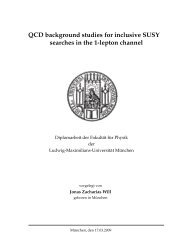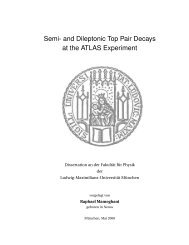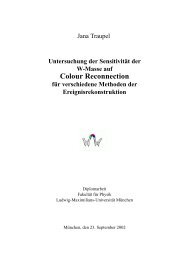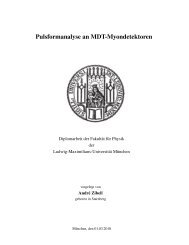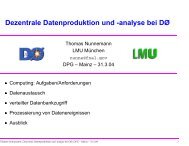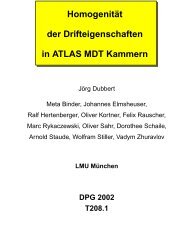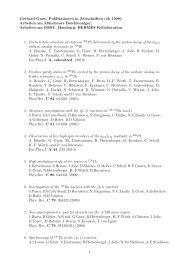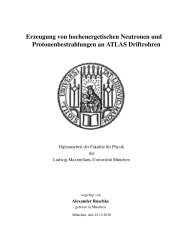development of micro-pattern gaseous detectors – gem - LMU
development of micro-pattern gaseous detectors – gem - LMU
development of micro-pattern gaseous detectors – gem - LMU
You also want an ePaper? Increase the reach of your titles
YUMPU automatically turns print PDFs into web optimized ePapers that Google loves.
46 Chapter 4 Energy Resolution and Pulse Height Analysis<br />
overnight measurements. This is due to the fact that the muon flux rate <strong>of</strong> 1cm −2 · min −1 [Grup 08]<br />
is rather small and results in a detection frequency <strong>of</strong> approximately 0.7 Hz.<br />
From Fig. 4.8 it is obvious that the Landau function fitted to the histogram is in good agreement<br />
with the data. However, one can observe that the spectrum is cut <strong>of</strong>f at low energies. This is an<br />
artefact <strong>of</strong> the preamplifier CATSA82 which amplifies the signal not high enough. The discriminator<br />
in the hardware readout chain had to be set at a threshold that prevented signals corresponding to a<br />
low energy loss <strong>of</strong> the muon from being detected. Therefore a complete analysis <strong>of</strong> the energy loss<br />
could not be accomplished. With the implementation <strong>of</strong> another preamplifier (ELab) this problem<br />
was solved and allows for further studies in the next section.<br />
4.3.2 Complete Pulse Height Analysis <strong>of</strong> Cosmic Signals<br />
By exchanging the preamplifier in the signal readout a full spectrum <strong>of</strong> energy loss distribution<br />
<strong>of</strong> cosmic ray muons is detectable. During the implementation <strong>of</strong> the ELab preamplifier also the<br />
five-fold segmented anode (cf. Ch. 3.1.1) was embedded. Fig. 4.9 shows an exemplary data set <strong>of</strong> a<br />
full energy loss spectrum.<br />
100<br />
90<br />
80<br />
Cu anode seg<br />
preamp: ELab<br />
Δ U<strong>gem</strong>3=<br />
360 V<br />
Δ U<strong>gem</strong>2=<br />
340 V<br />
Δ U<strong>gem</strong>1=<br />
320 V<br />
cm<br />
data_<strong>gem</strong>_0102_pulseheight_fit<br />
Entries 10000<br />
Mean 118.2<br />
RMS 76.18<br />
χ 2 / ndf 503.9 / 335<br />
70<br />
Prob<br />
Constant<br />
6.199e-09<br />
361.1 ± 5.9<br />
MPV 70.22 ± 0.69<br />
Sigma 26.65 ± 0.39<br />
kV<br />
Edrift<br />
= 1.25<br />
cm<br />
kV<br />
Eind<br />
= Etrans1,2<br />
= 2.00<br />
60<br />
50<br />
40<br />
30<br />
20<br />
10<br />
Cosmics Pulse Height<br />
Landau<br />
0<br />
0 50 100 150 200 250 300 350<br />
voltage [0.244mV]<br />
Figure 4.9: Pulse height spectrum <strong>of</strong> cosmic muons. Recording via ELab preamp. Full spectrum detectable.<br />
The green line corresponds to a Landau fit [Kolb 84]. Its quality is indicated by the χ 2 /nd f - value<br />
which should be close to 1 for a meaningful fit. Recent studies provide a different parametrization<br />
for the energy loss distribution for thin absorbers which differs from the commonly applied Landau<br />
distribution. The differences between the original Landau function and the fluctuations including<br />
“straggling function” (Landau-Bichsel-distribution) [Bich 06] can be seen in Fig 4.10. The solid line<br />
shows the corrected energy loss for minimum ionizing particle (βγ = 3.6) penetrating through a<br />
1.2 cm thin layer <strong>of</strong> Argon; whereas the dotted line indicates the original Landau function for such<br />
particle. The most probable value (MPV) is slightly shifted to lower energies and the distribution<br />
extents to zero. In comparison to that the classical Landau distribution provides a smaller range <strong>of</strong><br />
energy loss and a shorter tail. Comparing this with the experimental results it can be stated that the<br />
Landau-Bichsel function would describe the measurements better since the distribution also extends



